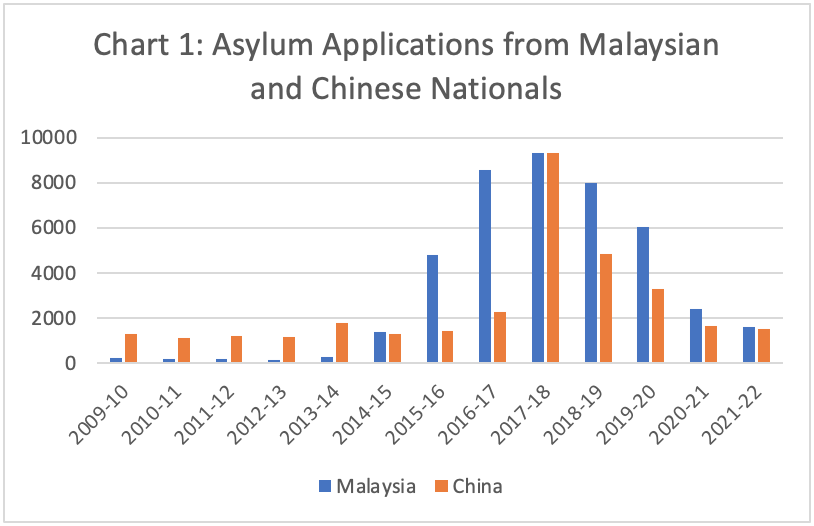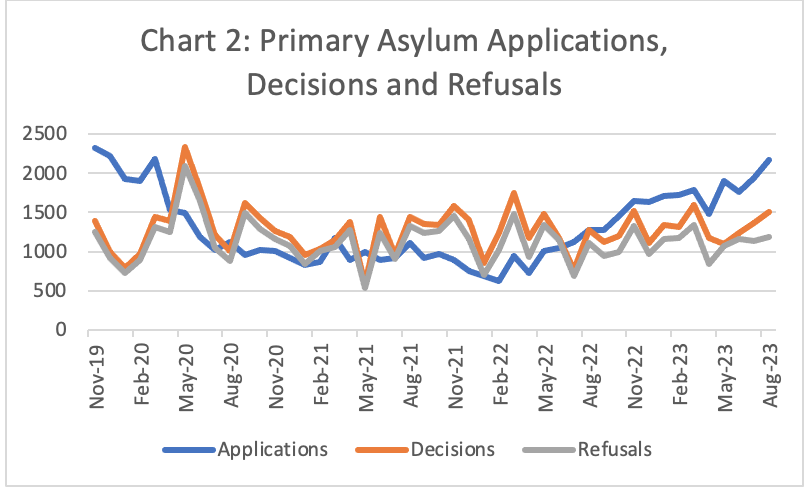After around eight years of policy paralysis and the biggest labour trafficking scam abusing the asylum system in our history, a scam that was largely neglected by Home Affairs Minister Dutton and his Secretary Mike Pezzullo, the Albanese Government has announced a $160 million package to “restore integrity to Australia’s refugee protection system”.
The Sydney Morning Herald and The Age’s chief political correspondent, David Crowe writes on the toxic nature of the debate, with Peter Dutton already trying to deflect blame by claiming that Labor in Government has “allowed 105,000 asylum seekers into our country over the last 15 months”.
This is patently false, and Dutton would know it given he was Minister for Home Affairs for many years. There were 94,260 asylum seekers in Australia at the time of the Election in 2022. This number has subsequently grown by 10,416 over the past 15 months to 104,676. We do not know what portion of the 10,416 asylum applicants arrived in Australia before or after the change of Government – some asylum seekers remain in Australia for years before they apply for asylum.
I have been writing on the growing asylum seeker numbers in this online journal and other places (including this article in the Sydney Morning Herald) since around 2017 when the labour trafficking scam was at its peak, driven by an extraordinary surge in asylum applications from Malaysian and Chinese nationals who had mostly arrived on visitor visas (see Chart 1). In 2017-18, there was a record 27,931 asylum applications, of which 18,627 (67 percent) were from just Malaysia and China.
There was no particularly new political unrest in those nations at that time that would have driven such an increase in asylum seekers from those nations. It was just that the lack of response from the Home Affairs Department made this an attractive proposition for labour traffickers – the lack of response would certainly have surprised the traffickers.

The primary level refusal rate for these applications was around 98 percent. As a result, a very large portion of the asylum seeker applications in Chart 1 are now at the Administrative Appeals Tribunal (AAT) or have gone underground. Some would have departed and a tiny number has been removed.
Understandably, primary asylum application numbers fell during the pandemic when international borders were closed. It was the ideal opportunity for government to get on top of the backlog but the Coalition Government surprisingly failed to act.
Since international borders re-opened, asylum applications at the primary stage have again steadily increased (see Chart 2). While some of these would be making genuine asylum claims, a substantial portion would be taking advantage of lengthy processing times to remain legally in Australia (with work rights at a time the labour market is super-hot). The backlog and long processing times act as a honeypot. Many would be assisted by registered or unregistered migration agents/lawyers who may or may not identify themselves with the applications they assist.

The nationality composition of asylum seekers has changed significantly in the past 15 months with Malaysian and Chinese asylum seekers now a much smaller portion of new applications, offset by a strong increase in asylum claims from Pacific Island nationals (due to the large increase in the Pacific Australia Labour Mobility (PALM) Scheme) as well as from India and Vietnam. In August 2023, almost 400 out of 2,164 asylum applications were from Pacific Island nationals.
Now that the Government has at last acted on this issue, two questions arise: (1) how effective will this response be? and (2) what more needs to be done?
A comprehensive response to a large asylum seeker backlog comprises five broad elements:
- Closer scrutiny at overseas posts of visitor and other visa applications from nationals with a high propensity to apply for asylum (and a low prospect of success). It would appear DHA has been scrutinising visitor applications from both Malaysia and China more closely for this purpose. But this may not be appropriate for PALM visa applicants. A different approach may be needed.
- Priority processing of new asylum applications (ie last in first out (LIFO)) to reduce the financial incentive to abuse the asylum system. The Government has allocated an additional $54 million for faster primary stage processing and $58 million to the AAT and the Federal Court “to help break the business model of those who abuse the system and ensure a faster, fairer and more efficient protection system for those genuinely in need of Australia’s protection”.
- Rapid removal of asylum seekers refused under the LIFO approach. The Government has allocated an additional $50 million over four years to begin restoring immigration compliance funding that had been run down after this function was transferred to Australian Border Force (ABF). Immigration compliance is to be taken out of ABF and will re-join other immigration policy and administration functions – a very sensible move to undo the damage done by Pezzullo’s administrative architecture. A key will be whether this is sufficient funding to address the volume of immigration abuse and malpractice the Nixon Report identified. I suspect it is far too little.
- Targeting of migration agents/lawyers (registered and unregistered) heavily involved with unmeritorious asylum applications for investigation and prosecution. The Government has indicated it will double resources of the Office of the Migration Agent Registration Authority, increase penalties for misconduct and make Operation Inglenook a permanent strike force to address wider misconduct in the visa system. This is good but once again may not go far enough.
- Find acceptable visa solutions for asylum seekers who have been finally refused but either cannot afford to depart or are unwilling to depart. Given over 75,000 asylum seekers have been refused at primary stage, this will be a massive task. The Government has given little indication of what it proposes for this cohort. It will need to re-visit this issue.
Finally, the Government has also allocated $48 million to boost legal assistance services “to support applicants through the asylum process”. Where this funding helps applicants with a strong case to put forward their claims more clearly, this will help speed up positive decisions for people with a genuine fear of persecution. The risk is if this funding is used by migration agents/lawyers to ‘gild the lily’ on weak and/or unmeritorious cases. That would slow processing and be detrimental to the strategy.
An incidental benefit from this funding may be to placate asylum lawyers and advocates from attacking the Government on its proposed crackdown. Asylum lawyers and advocates have regularly attacked anyone, including myself, who has suggested government cannot just allow this situation to continue. It’s just part of their ideology to refuse to accept there are any unmeritorious asylum applications.
The Kaldor Centre is already ecstatic about the funding for asylum lawyers in an extraordinarily superficial analysis of the situation.
If asylum lawyers and advocates are placated by this funding for them, that may also negate the likely political attack from the Greens that would by now have taken place. Kristina Keneally was automatically and mindlessly attacked by the Greens when she raised this issue prior to the pandemic.
But how will we know if this strategy is working and whether the Government has done enough to get on top of the issue? In addition to a rise in unscrupulous agents/lawyers being sanctioned and de-registered and unregistered agents and labour hire companies being prosecuted, we should see:
- the rise in asylum applications begin to plateau and then decline from its most recent level of 2,164 in August 2023 – that will take a number of months;
- a significant increase in asylum cases processed at the primary stage from currently around 1,500 in August 2023 to well over 3,000 per month resulting in the primary backlog starting to fall;
- a major increase in asylum cases processed at the AAT rising from the current level of around 500 per month to well over 2,000 per month resulting in the AAT backlog plateauing at just over 40,000 and then declining;
- a significant increase in voluntary departures (data on this needs to be published by DHA) as well as voluntary and involuntary removals from currently around 15 per month to well over 50-100 per month – the rise in removals will inevitably attract criticism from asylum advocates and parts of the media;
- a temporary increase in the number of asylum seekers granted permanent protection as more applications are processed. As part of that the Government will also need to find a solution for the 12,000 remaining legacy boat arrivals who are now in limbo as their applications have been refused.
In total, that should result in a small decline in the number of asylum seekers in the country from the current 105,000 (or at least a slowing in the rate of growth). We should start to see that from early 2024 as it will take time for this strategy to take effect. The Albanese Government should have implemented this strategy 6-12 months ago. It did not need to wait for the Nixon Report as it knew of this issue and what needed to be done from well before the pandemic.
In addition to the response to this strategy from asylum lawyers/advocates and the Greens, it will be interesting to see how the usual suspects in the Murdoch press responds. Throughout the period the major labour trafficking scam was taking place prior to the pandemic, the Murdoch press was eerily silent on this issue. It only began reporting on this from early 2023.
If the Murdoch press had reported on this from 2017, when the scam became apparent, there is a chance Dutton and Pezzullo may have responded given their penchant for listening to the Murdoch press. That would have limited growth in asylum numbers. But sadly the Murdoch press only becomes interested on border protection when it can find a way to blame Labor.
Finally, it should be recognised that what the Government has announced is essentially designed to stop the size of the problem from growing. It will need to come back to the issue again if it is to significantly reduce the over 75,000 unsuccessful asylum seekers living in the community without work rights, access to services, etc and subject to ongoing exploitation.
Abul Rizvi PhD was a senior official in the Department of Immigration from the early 1990s to 2007 when he left as Deputy Secretary. He was awarded the Public Service Medal and the Centenary Medal for services to development and implementation of immigration policy, including the reshaping of Australia’s intake to focus on skilled migration, slow Australia’s rate of population ageing and boost Australia’s international education and tourism industries.

